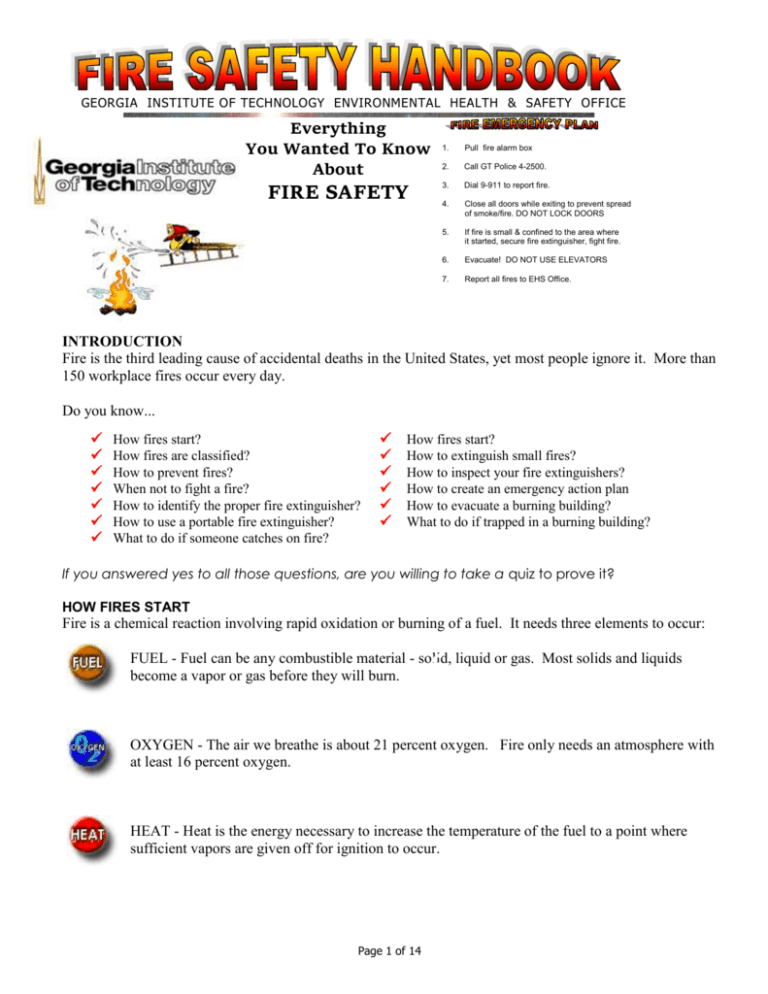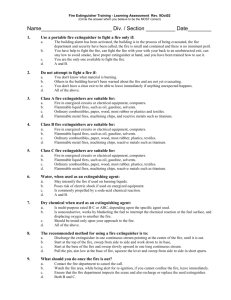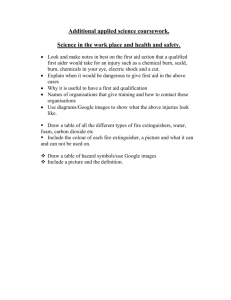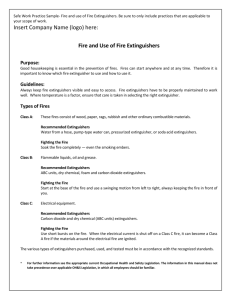
GEORGIA TECH ENVIRONMENTAL HEALTH & SAFETY OFFICE
GEORGIA INSTITUTE OF TECHNOLOGY ENVIRONMENTAL HEALTH & SAFETY OFFICE
Everything
You Wanted To Know
About
FIRE SAFETY
(But Were Afraid To Ask)
1.
Pull fire alarm box
2.
Call GT Police 4-2500.
3.
Dial 9-911 to report fire.
4.
Close all doors while exiting to prevent spread
of smoke/fire. DO NOT LOCK DOORS
5.
If fire is small & confined to the area where
it started, secure fire extinguisher, fight fire.
6.
Evacuate! DO NOT USE ELEVATORS
7.
Report all fires to EHS Office.
INTRODUCTION
Fire is the third leading cause of accidental deaths in the United States, yet most people ignore it. More than
150 workplace fires occur every day.
Do you know...
How fires start?
How fires are classified?
How to prevent fires?
When not to fight a fire?
How to identify the proper fire extinguisher?
How to use a portable fire extinguisher?
What to do if someone catches on fire?
How fires start?
How to extinguish small fires?
How to inspect your fire extinguishers?
How to create an emergency action plan
How to evacuate a burning building?
What to do if trapped in a burning building?
If you answered yes to all those questions, are you willing to take a quiz to prove it?
HOW FIRES START
Fire is a chemical reaction involving rapid oxidation or burning of a fuel. It needs three elements to occur:
FUEL - Fuel can be any combustible material become a vapor or gas before they will burn.
A
B
solid,
C
liquid or gas. Most solids and liquids
OXYGEN - The air we breathe is about 21 percent oxygen. Fire only needs an atmosphere with
at least 16 percent oxygen.
HEAT - Heat is the energy necessary to increase the temperature of the fuel to a point where
sufficient vapors are given off for ignition to occur.
Page 1 of 14
GEORGIA TECH ENVIRONMENTAL HEALTH & SAFETY OFFICE
CHEMICAL REACTION - A chain reaction can occur when the three elements of
fire are present in the proper conditions and proportions.
Fire occurs when this rapid oxidation, or burning takes place.
Take any one of these factors away, and the fire cannot occur or will be extinguished
if it was already burning.
HOW FIRES ARE CLASSIFIED
CLASS A
Ordinary combustibles or fibrous material, such as wood, paper, cloth, rubber and
some plastics
CLASS B
Flammable or combustible liquids such as gasoline, kerosene, paint, paint thinners,
propane and cooking oils/grease.
CLASS C
Energized electrical equipment, such as appliances, switches, panel boxes and
power tools.
CLASS D
Certain combustible metals, such as magnesium, titanium, potassium and sodium.
These metals burn at high temperatures and give off sufficient oxygen to support
combustion. They may react violently with water or other chemicals, and must be
handled with care.
Page 2 of 14
GEORGIA TECH ENVIRONMENTAL HEALTH & SAFETY OFFICE
HOW TO PREVENT FIRES
Class A — Ordinary combustibles:
Keep storage and working areas free of trash. Place oily rags in covered containers.
Class B — Flammable liquids or gases:
Don't refuel gasoline-powered equipment in a confined space, especially in the presence of an open flame
such as a furnace or water heater.
Don't refuel gasoline-powered equipment while it's hot.
Keep flammable liquids stored in tightly closed, self-closing, spill-proof containers,
U.L. safety can. Pour from storage drums only what you'll need.
i.e.
Store flammable liquids away from spark-producing sources. Bond the two containers together to prevent
static spark
Use flammable liquids only in well-ventilated areas.
Class C — Electrical equipment:
Look for old wiring, worn insulation and broken electrical fittings. Report any hazardous condition
to your supervisor.
Prevent motors from overheating by keeping them clean and in good working order. A spark from a
rough-running motor can ignite the oil and dust in it.
Utility lights should always have some type of wire guard over them. Heat from an
uncovered light bulb can easily ignite ordinary combustibles.
Don't misuse fuses. Never install a fuse rated higher than specified for the circuit.
Investigate any appliance or electrical equipment that smells strange. Unusual odors can be the first sign of
fire.
Don’t overload wall outlets. Two outlets should have no more than two plugs.
Class D — Metals:
Flammable metals such as magnesium and titanium generally take a very hot heat source to ignite; however,
once ignited are difficult to extinguish as the burning reaction produces sufficient oxygen to support
combustion, even under water.
In some cases, covering the burning metal with sand can help contain the heat and sparks from the reaction.
Class D extinguishing agents are available (generally as a dry powder in a bucket or box) which can be quite
effective. These agents are available upon request from the EH&S Office.
Page 3 of 14
GEORGIA TECH ENVIRONMENTAL HEALTH & SAFETY OFFICE
If you are planning a research project using a large amount of flammable metals you should consider
requesting a ten pound Class-D extinguisher as a precaution.
Pure metals such as potassium and sodium react violently (even explosively) with water and some other
chemicals, and must be handled with care. Generally these metals are stored in sealed containers in a nonreactive liquid to prevent decay (surface oxidation) from contact with moisture in the air.
White phosphorus is air-reactive and will burn/explode on contact with room air. It must be kept in a sealed
container with a non-reactive solution to prevent contact with air.
Some of these metals may not be uncommon in labs on Georgia Tech campuses, but are generally only
found in small quantities and accidental fires/reactions can be controlled or avoided completely through
knowledge of the properties of the metals and using good judgement and common sense.
The researcher should be familiar with the characteristics, MSDS, and adverse reactions of the various
chemicals he or she is using.
WHEN NOT TO FIGHT A FIRE
Never fight a fire:
If the fire is spreading beyond the spot where it started
If you can't fight the fire with your back to an escape exit
If the fire can block your only escape
If you don't have adequate fire-fighting equipment
In any of these situations,
DON'T FIGHT THE FIRE YOURSELF.
CALL FOR HELP.
Page 4 of 14
GEORGIA TECH ENVIRONMENTAL HEALTH & SAFETY OFFICE
HOW TO EXTINGUISH SMALL FIRES
Class A - Extinguish ordinary combustibles by cooling the material below its
ignition temperature and soaking the fibers to prevent re-ignition.
Use pressurized water, foam or multi-purpose(ABC-rated) dry chemical
extinguishers. DO NOT USE carbon dioxide or ordinary (BC-rated) dry
chemical extinguishers on Class A fires.
Class B - Extinguish flammable liquids, greases or gases by removing the
oxygen, preventing the vapors from reaching the ignition source or
inhibiting the chemical chain reaction.
Foam, carbon dioxide, ordinary (BC-rated) dry chemical, multi-purpose dry
chemical, and halon extinguishers may be used to fight Class B fires.
Do not use water to fight a class B fire.
Class C - Extinguish energized electrical equipment by using an
extinguishing agent that is not capable of conducting electrical currents.
Carbon dioxide, ordinary (BC-rated) dry chemical, multi-purpose dry
chemical and halon* fire extinguishers may be used to fight Class C fires.
DO NOT USE water extinguishers on energized electrical equipment.
* Even though halon is widely used, EPA legislation is phasing it out of use in favor of
agents less harmful to the environment.
Class D - Extinguish combustible metals such as
magnesium, titanium, potassium and sodium with dry
powder extinguishing agents specially designated for
the material involved.
In most cases, they absorb the heat from the material,
cooling it below its ignition temperature.
NOTE: Multipurpose (ABC-rated) chemical extinguishers leave a residue that can harm sensitive
equipment, such as computers and other electronic equipment. Because of this, carbon dioxide, or halon or
cleaner agent extinguishers are preferred in these instances because they leave very little residue.
ABC dry powder residue is mildly corrosive to many metals. For example, residue left over from the use of
an ABC dry powder extinguisher in the same room with a piano can seriously corrode piano wires.
Page 5 of 14
GEORGIA TECH ENVIRONMENTAL HEALTH & SAFETY OFFICE
Carbon dioxide, halon or ABC multipurpose extinguishers are provided for most labs and computer areas on
campus.
Class K fire extinguishers are “wet” chemicals and used to extinguish kitchen grease fires.
The 10-poind ABC multipurpose fire extinguisher is the standard fire extinguisher for Georgia Tech with
the above exception.
HOW TO IDENTIFY THE PROPER FIRE EXTINGUISHER
All ratings are shows on the extinguisher faceplate. Some extinguishers are marked with multiple ratings
such as AB, BC and ABC. These extinguishers are capable of putting out more than one class of fire.
Class A and B extinguishers carry a numerical rating that indicates how large a fire an experienced person
can safely put out with that extinguisher.
Class C extinguishers have only a letter rating to indicate that the extinguishing agent will not conduct
electrical current. Class C extinguishers must also carry a Class A or B rating.
Class D extinguishers carry only a letter rating indicating their effectiveness on certain amounts of specific
metals.
HOW TO USE A PORTABLE FIRE EXTINGUISHER
Remember the acronym, "P.A.S.S."—
Pull the Pin.
Aim the extinguisher nozzle at the base of
the flames.
Squeeze trigger while holding the
extinguisher upright
Sweep the extinguisher from side to side,
covering the area of the fire with the
extinguishing agent.
Page 6 of 14
GEORGIA TECH ENVIRONMENTAL HEALTH & SAFETY OFFICE
REMEMBER:
Should your path of escape be threatened
Should the extinguisher run out of agent
Should the extinguisher prove to be ineffective
Should you no longer be able to safely fight the fire
...THEN LEAVE THE AREA IMMEDIATELY!
HOW TO INSPECT YOUR FIRE EXTINGUISHERS
Know the locations of the fire extinguishers in your work area.
Make sure the class of the extinguisher is safe to use on fires likely to occur in the immediate area.
All fire extinguishers should be checked monthly by the occupants.
Check the plastic seal holding the pin in the extinguisher handle. Has the extinguisher been tampered with
or used before? Report any broken/missing seals/pins to the Environmental Health & Safety (EHS)
Manager or the Campus Fire Safety Coordinator.
Look at the gauge and feel the weight. Is the extinguisher full? Does it need to be recharged?
Water, some foam, and dry chemical extinguishers have gauges indicating the pressure inside the
extinguisher. The pressure needle should be in the "green" area (generally 100-175 lbs., depending
on the type of agent).
CO2 (carbon dioxide) extinguishers are high pressure cylinders with pressures ranging from 1500 lb
to 2150 lb. These extinguishers DO NOT have gauges and must be weighed by our Fire
Extinguisher contractor to determine the amount of contents remaining.
Make sure the pin, nozzle and nameplate are intact.
The Fire Extinguisher Contractor under the guidance of the EHS Manager inspects and services all Georgia
Tech fire extinguishers on a year-round basis, but we would still encourage you to be aware of the condition
of your area's extinguishers by visual inspection on a frequent basis to ensure you have a working
extinguisher there when you need one.
Report any missing, empty or damaged fire extinguishers to the EH&S Office whenever you notice any
discrepancies.
Page 7 of 14
GEORGIA TECH ENVIRONMENTAL HEALTH & SAFETY OFFICE
The APPEARENCE of different types of extinguishers:
Generally, you can tell with a glance which type an extinguisher is hanging on the wall, or in the cabinet,
just by looking at its shape. Check the labels of the extinguishers in your area and note the color and
shape/size of the extinguisher. This may help if someone runs in to help you fight a fire with the WRONG
extinguisher (i.e. water on an electrical fire) - you can STOP them before they are injured or make matters
worse!
ABC-rated multipurpose dry powder extinguishers
are the most common at GPC campuses, particularly in the
corridors of academic buildings. They are almost
always RED in color and have either a long
narrow hose or no hose (just a short nozzle).
These extinguishers are very light (5-25 lbs total weight)
Halon extinguishers look virtually identical to ABC
multipurpose dry chemical extinguishers.
CO2 (carbon dioxide) extinguishers are generally red have a LARGE "tapered" nozzle
(horn), are HEAVIER (15-45 lbs.) These are all high-pressure cylinders. Care should
be used not to drop a CO2 cylinder; if it is damaged it can punch a hole through the
nearest wall(s) and end up on the other side of campus! (The containers are quite
sturdy, but don't abuse them) CO2 cylinders do not have a pressure gauge – they must
be weighed to determine the amount of contents.
"WHERE can I find a fire extinguisher on campus?"
In the corridors of academic and office buildings, and inside very large rooms.
In or immediately outside all laboratories where chemicals are stored and used.
In or immediately outside mechanical spaces where motorized or other equipment is present which
might reasonably cause a fire.
In electrical closets, storage buildings, and mounted inside certain Georgia Tech vehicles.
If you can't find the fire extinguisher in your area, or feel you need different type/size of extinguisher for
your work area or laboratory, contact the the EH&S Office (404-894-4635).
"If I just use a little, do I have to report the extinguisher as USED?"
YES! We want FULL extinguishers at all GPC campus locations.
Page 8 of 14
GEORGIA TECH ENVIRONMENTAL HEALTH & SAFETY OFFICE
While CO2 and halon extinguishers will generally hold their pressure after a slight discharge, BC and ABC
rated DRY CHEMICAL extinguishers will usually NOT hold a charge after partial use. This is true for
all your personal home and vehicle dry chemical extinguishers, too!
While the gauge may hold steady in the green immediately after a slight use, check it the next day and you'll
find the gauge on EMPTY! This is because upon use the dry powder gets inside the seals and allows the
nitrogen carrier to escape over a period of time.
After ANY use a BC or ABC extinguisher MUST be serviced and recharged. This is very important for
home extinguishers also; YOU MUST HAVE THE EXTINGUISHER REFILLED AFTER ANY USE.
You cannot "test" an extinguisher and put it back in the cabinet!
If you want to try out an extinguisher and learn how it feels to use one, contact the EH&S Office and they'll
arrange for you to attend a fire extinguisher classes where you can actually get some “hands-on” use.
Warning to thieves and vandals: Fire extinguishers and types of fire equipment on the Georgia Tech
campus are traceable and theft of or damage to emergency equipment is a serious crime.
HOW TO EVACUATE A BURNING BUILDING
The last one out of the room should not lock the door, just close it. Locking the door hinders the fire
department's search and rescue efforts.
Proceed to the exit as outlined in the Emergency Action Plan. Follow the exit signs to the exit. Proceed
in a calm and orderly manner. If one egress path is blocked by fire and smoke, use the other one.
NEVER, NEVER use elevators under any circumstances.
Stay low to avoid smoke and toxic gases. The best air is close to the floor, so crawl if necessary.
If possible, cover your mouth and nose with a damp cloth to help you breathe.
If you work in a building with multiple stories, a stairway will be your primary escape route. Most
enclosed stairwells in buildings over two stories are "rated" enclosures and will provide you a safe
means of exit; don't panic descend stairs slowly and carefully.
Once in the stairwell, proceed down to the first floor. Never go up.
Once outside the building, report to a predetermined safe area, usually 50 feet away, so that a head count
can be taken.
WHAT TO DO IF TRAPPED IN A BURNING BUILDING
Page 9 of 14
GEORGIA TECH ENVIRONMENTAL HEALTH & SAFETY OFFICE
If you're trying to escape a fire, never open a closed door without feeling it first. Use the back of your
hand to prevent burning your palm. If the door is hot, try another exit. If none exists, seal the cracks
around the doors and vents with anything available.
If in a room, use wet towels to seal the space under the door and prevent the entry of smoke. Cracks
around the door can be sealed with masking tape if necessary.
If trapped, look for a nearby phone or use your cell phone and call theGeorgia Tech Police Department
(404894-2500), giving them your exact location.
If breathing is difficult, try to ventilate the room, but don't wait for an emergency to discover that
window can't be opened.
If you can't contact the Georgia Tech Police by phone, wave for attention at the window. Don't panic.
WHAT TO DO IF SOMEONE CATCHES ON FIRE
If you should catch on fire:
STOP - where you are
DROP - to the floor
ROLL - around on the floor
This will smother the flames, possibly saving your life.
Just remember to STOP, DROP and ROLL.
If a co-worker catches on fire, smother flames by grabbing a blanket or rug and wrapping them up in it.
That could save them from serious burns or even death.
SUMMARY
KNOW LEDGE AWARENESS PRE PARATION
These are your keys to preventing and surviving fires wherever they occur.
Page 10 of 14
GEORGIA TECH ENVIRONMENTAL HEALTH & SAFETY OFFICE
1.
2.
Pull fire alarm box
Notify Protective Service at 404-894-2500
3.
Dial 9-911 to report fire
4.
Close all doors while exiting to prevent spread of smoke/fire.
NOT LOCK DOORS
5.
If fire is small & confined to the area where started, secure fire
extinguisher, fight fire.
6.
Evacuate! DO NOT USE ELEVATORS.
Ensure that everyone is out including those with disabilities.
7.
Report all fires to EH&S Office.
Page 11 of 14
DO
GEORGIA TECH ENVIRONMENTAL HEALTH & SAFETY OFFICE
Everyone must do their part to prevent fires Plan Ahead
WHAT TO DO IN CASE
OF FIRE IN THE HOME
Have a fire emergency plan
Install fire extinguishers/smoke detectors
Have two escape routes
Practice until it's a habit
Store flammables safely
Designate a place of assembly away from fire
Page 12 of 14
GEORGIA TECH ENVIRONMENTAL HEALTH & SAFETY OFFICE
QUIZ
Can you correctly answer TRUE or FALSE for each question below?
1. Fire requires fuel, oxygen and heat for ignition to occur. Taken any one away and the
fire cannot occur.
2. Fire needs an atmosphere of 21 percent oxygen - the same as the air we breathe - to
sustain ignition.
3. Class A fires are fueled by ordinary combustible or fibrous material, such as wood,
paper, cloth and some plastics.
4. Class B fires include flammable or combustible liquids, greases and gases, such as
gasoline, paint and propane.
5. Class C fires include electrical equipment, such as motors and heaters that are not
connected to a power source.
6. Combustible metals (Class D) are difficult to extinguish, because once ignited, they give
off sufficient oxygen to support combustion.
7. Class D fires can be extinguished with water.
8. Keeping the work area free of litter is one way to help prevent Class A fires.
9. Gasoline-powered equipment can be refueled while hot if refueling is done in a wellventilated area.
10. You may use a higher-amp fuse than is specified for an electrical circuit if you first tag
the fuse box to mark the change.
11. Unusual odors from electrical equipment can be the first sign of a potential fire.
12. If the fire you are fighting begins to spread, leave the area and call for help.
13. Do not use carbon dioxide or ordinary dry chemical extinguishers on Class A fires.
14. Do not use water extinguishers on energized electrical equipment.
15. An Emergency Action Plan should designate one person to evacuate all disabled people
in the building.
16. Fire drills are necessary to test the Emergency Action Plan.
17. The last person to evacuate a room should lock the door to prevent vandalism or theft of
equipment.
18. Elevators may be used to evacuate a building as long as they remain operable.
19. You should occasionally pull the pin and briefly squirt all fire extinguishers to ensure
they are properly charged and in good working order.
20. As soon as you evacuate a burning building, go home. No need to hang around.
Page 13 of 14
GEORGIA TECH ENVIRONMENTAL HEALTH & SAFETY OFFICE
Answers:
1-T,2-F,3-T,4-T,5-T,6-T,7-F,8-T,9-F,10-F, 11-T,12-T,13-T,14-T,15-F,16-T,17-F,18-F,19-F,20-F
Fire Safety questions may be referred to the Fire Safety Coordinator 404-894-4635
The Fire Safety Handbook, 2002,Georgia Institute Of Technology. All rights reserved.
Developer: Alton Chin-Shue, Safety Coordinator
Page 14 of 14




